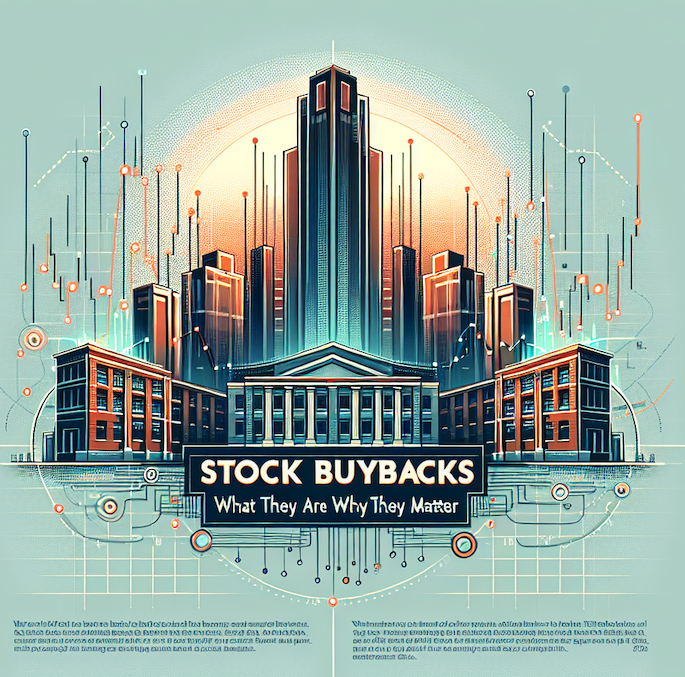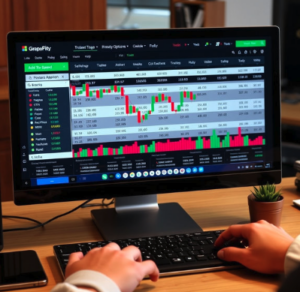
Stock buybacks, also known as share repurchases, have become a critical component of corporate finance over the last several decades. While their fundamental goal is to enhance shareholder value, the reasoning behind their implementation is multifaceted and often debated. In 2024, buybacks continue to be a topic of considerable interest in financial circles, raising questions about their long-term benefits and potential risks. This article provides a comprehensive overview of stock buybacks, explaining what they are, how they work, the reasons companies choose to engage in them, their impact on the market, and the ongoing debate surrounding their use.
What Are Stock Buybacks?
At their core, stock buybacks involve a company repurchasing its own shares from the market. This reduces the total number of outstanding shares, which can increase the value of the remaining shares. Stock buybacks are often viewed as a way for companies to return excess capital to shareholders, and they are a popular alternative to paying dividends. The process of stock buybacks can be performed through two main methods: open market repurchases or tender offers. In open market repurchases, the company buys shares directly from the stock exchange at prevailing market prices. In tender offers, the company offers to purchase a set number of shares from shareholders at a predetermined price, typically above the market price, to encourage shareholders to sell.
The decision to repurchase shares is typically made by a company’s board of directors and can be motivated by several factors, including the desire to signal confidence in the company’s prospects, boost earnings per share (EPS), and return capital to shareholders. Stock buybacks are most often seen as a sign that a company has a surplus of cash and does not have immediate plans to reinvest that cash into new projects or acquisitions. Buybacks can be particularly attractive during times of low-interest rates when borrowing money for repurchases is cost-effective.
How Stock Buybacks Work
The mechanics of stock buybacks are relatively straightforward, but the implications can be far-reaching for a company’s financial performance and stock price.
-
Decision to Repurchase Shares
The first step in a stock buyback is the decision made by the company’s board of directors to repurchase shares. This decision is influenced by several factors, including the company’s cash reserves, stock valuation, and financial outlook. If a company believes its stock is undervalued and has excess cash or access to low-cost borrowing, it may opt to repurchase shares rather than investing the money in new projects or returning it to shareholders in the form of dividends. -
Announcing the Buyback
Once the decision to repurchase shares is made, companies typically announce the buyback to the public. The announcement often includes key details such as the total number of shares to be repurchased, the method of repurchase (open market or tender offer), and the duration of the program. Transparency is essential in this stage, as the announcement allows investors to assess the company’s financial strategy and determine whether they want to buy or sell shares based on the buyback plan. -
Executing the Repurchase
There are two primary ways companies can execute a stock buyback:- Open Market Repurchase: In this method, the company buys its shares on the open market like any other investor. The repurchase takes place over an extended period, and the company purchases shares as long as they remain below a set price or within a specified budget.
- Tender Offer: A tender offer occurs when a company makes a formal offer to purchase shares from its shareholders at a fixed price, usually at a premium above the current market price. Shareholders can choose to tender their shares at this price, but they are not required to do so.
-
Funding the Buyback
A company may fund its stock buyback in different ways. The most common method is using excess cash reserves accumulated from strong earnings or profits. Alternatively, some companies choose to borrow money by issuing bonds or taking out loans, especially if the interest rates are low. Companies with substantial cash holdings, such as major tech firms like Apple or Microsoft, may prefer to use their available cash to finance the buyback, as this avoids incurring new debt. -
Effect on Shares Outstanding
When a company repurchases its shares, the total number of outstanding shares decreases. This reduction in shares outstanding leads to a higher earnings per share (EPS) because the company’s earnings are now divided among fewer shares. The impact on EPS can be significant, especially if the company repurchases a large number of shares. In addition, the reduced supply of shares can push the stock price higher due to increased demand for the remaining shares. -
Market Reactions
The market’s reaction to stock buybacks can vary depending on the context. In many cases, buybacks are perceived as a positive signal, particularly if the company is repurchasing shares at a time when its stock price is undervalued. Investors often view buybacks as a sign that the company’s management has confidence in the company’s future growth prospects. However, some investors may view stock buybacks with skepticism, particularly if the company is using repurchases to prop up its stock price in the short term without addressing underlying operational issues. -
Completion of the Buyback
After the repurchase program is completed, the company will typically announce the final results. If the buyback was successful in achieving its objectives—whether it was to increase EPS, signal confidence to the market, or return capital to shareholders—the company may announce its intention to repurchase additional shares in the future. In some cases, companies may extend the buyback program if they believe their stock remains undervalued.
Why Companies Use Stock Buybacks
Companies engage in stock buybacks for several strategic reasons. While the primary objective is usually to increase shareholder value, other considerations also come into play.
-
Increasing Earnings per Share (EPS)
One of the most immediate benefits of a stock buyback is the increase in earnings per share (EPS). EPS is a key metric used by analysts and investors to assess a company’s profitability. When a company buys back shares, the same earnings are now spread over a smaller number of shares, which leads to an increase in EPS. This can make the company’s financials appear stronger, even if the company’s actual profitability has not increased. -
Returning Capital to Shareholders
Stock buybacks provide a method for companies to return excess capital to shareholders. This is particularly useful for companies that have more cash than they need for immediate investment or expansion. Unlike dividends, which are paid out regularly and create an ongoing obligation for the company, buybacks offer greater flexibility. Companies can repurchase shares when they have surplus funds, without committing to a recurring payment like a dividend. -
Signaling Confidence in the Company
Another reason companies engage in buybacks is to send a positive signal to the market. When a company buys back shares, it is essentially communicating that it believes its stock is undervalued. Management may feel that the current stock price does not reflect the company’s true value, and a repurchase program is a way of demonstrating confidence in the company’s prospects. -
Preventing Hostile Takeovers
For companies with relatively few shares in circulation or with a controlling interest held by a small number of investors, buybacks can be a strategy to prevent hostile takeovers. By repurchasing shares, the company can increase the cost of acquiring control of the company, making it less vulnerable to unwanted takeover attempts. -
Offsetting Dilution from Stock-Based Compensation
Many companies issue new shares as part of their employee compensation plans, particularly in the form of stock options. These new shares can dilute the value of existing shares. To offset this dilution, companies may engage in stock buybacks to repurchase a similar number of shares, keeping the total number of outstanding shares relatively stable. -
Tax Efficiency
Stock buybacks are often viewed as more tax-efficient than paying dividends. While dividends are taxed as income, stock buybacks can result in capital gains, which are typically taxed at a lower rate. This makes buybacks particularly attractive for high-income investors or institutional shareholders who want to minimize their tax burden. -
Boosting Stock Price
Another common reason for stock buybacks is to boost the stock price. By reducing the number of shares in circulation, buybacks can lead to an increase in stock prices due to the basic principle of supply and demand. A smaller supply of shares, combined with constant or growing demand, can push the stock price higher, benefiting both the company and its shareholders.
The Impact of Stock Buybacks on the Market
The market’s reaction to stock buybacks can be complex and varies depending on various factors, including the broader economic climate and investor sentiment.
-
Stock Price Appreciation
The most immediate effect of stock buybacks is often an increase in stock price. Reducing the number of shares outstanding increases demand for the remaining shares, which can push the stock price higher. In many cases, the announcement of a buyback program results in a short-term spike in stock price. -
Improved Earnings per Share (EPS)
As mentioned earlier, stock buybacks increase EPS by reducing the number of shares over which earnings are spread. This can make the company’s financial results look better, which may attract new investors and boost the stock price further. -
Investor Sentiment
Buybacks can have a significant impact on investor sentiment. A company that repurchases shares is often seen as strong and confident, especially if it is buying shares at a time when its stock is undervalued. This can encourage both short-term and long-term investors to buy shares, driving up the stock price. -
Market Liquidity
Stock buybacks can also impact market liquidity. By repurchasing shares, companies create buying pressure in the market, which can improve liquidity. This may make it easier for other investors to buy or sell shares, as the buybacks contribute to a higher volume of trades.
Criticism and Controversies Surrounding Stock Buybacks
While stock buybacks are popular, they have faced criticism and controversy over the years. Some argue that buybacks prioritize short-term financial gains over long-term growth, while others raise concerns about their impact on income inequality.
-
Manipulation of Stock Prices
Some critics argue that stock buybacks are used to manipulate stock prices. By repurchasing shares, companies can artificially inflate their stock price, even if the underlying business performance does not justify the increase. This practice can mislead investors and create an unsustainable rise in stock prices. -
Focus on Short-Term Gains
Stock buybacks can be seen as a way to boost short-term stock prices rather than focusing on long-term business growth. Instead of investing in new projects, research, or acquisitions, companies may choose to use their cash to repurchase shares. This can hinder long-term innovation and sustainable growth, potentially leaving companies ill-prepared for future challenges. -
Inequality Concerns
Another criticism of stock buybacks is that they disproportionately benefit wealthy shareholders. Since stock buybacks typically raise share prices, those who own the most shares—often institutional investors and executives—stand to gain the most. This has led to concerns about widening income inequality, as ordinary workers may not benefit from the increased stock prices. -
Undervaluation of Long-Term Investments
Some analysts argue that companies should focus on long-term investments, such as research and development, instead of repurchasing shares. By reinvesting profits into innovation and growth, companies can build sustainable value over time, benefiting both the company and the economy.
The Future of Stock Buybacks
Stock buybacks are likely to remain a central part of corporate finance in the future, but their role may evolve in response to changing market conditions and growing scrutiny from regulators. As policymakers consider measures to limit or tax buybacks, companies will need to balance the benefits of stock repurchases with their responsibility to invest in long-term growth and development.
In conclusion, stock buybacks are a powerful financial tool with both positive and negative implications. While they can provide immediate benefits such as increased EPS, higher stock prices, and capital return to shareholders, they also raise important questions about long-term business priorities and income inequality. As the financial landscape continues to evolve, companies, investors, and policymakers will need to carefully consider the role of stock buybacks in shaping the future of corporate finance.
Feel free to check out our other website at : https://synergypublish.com


